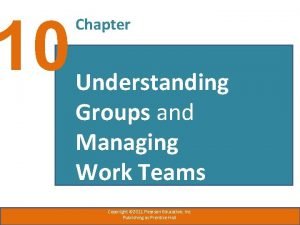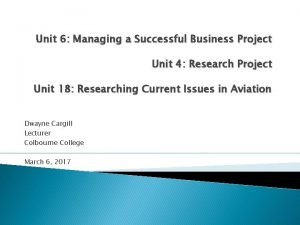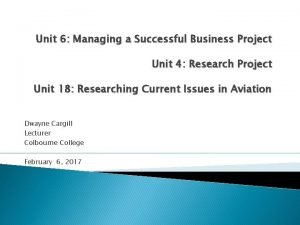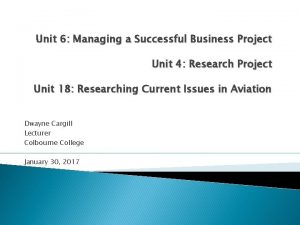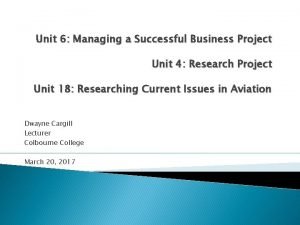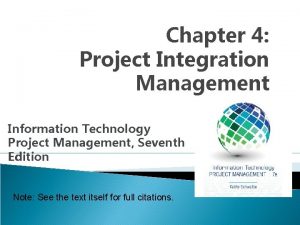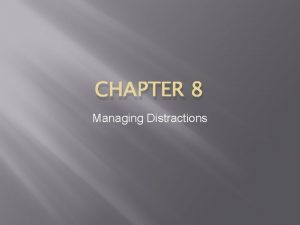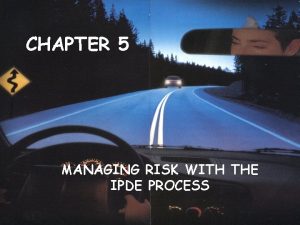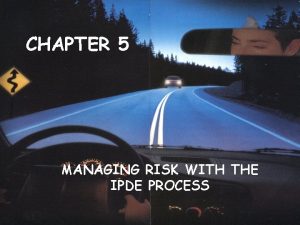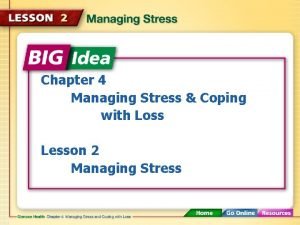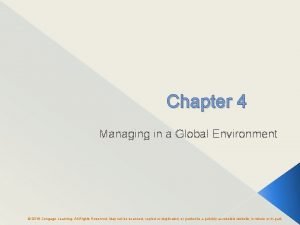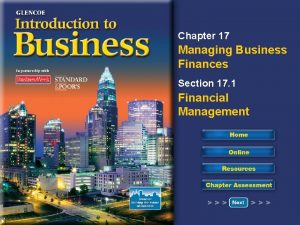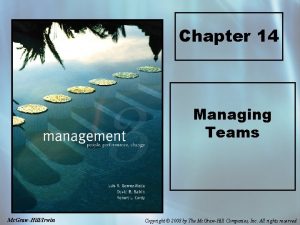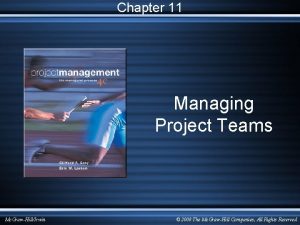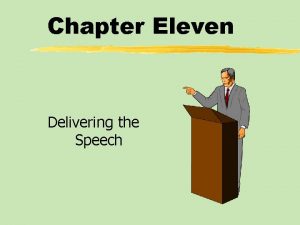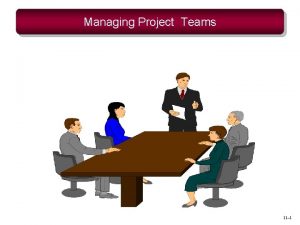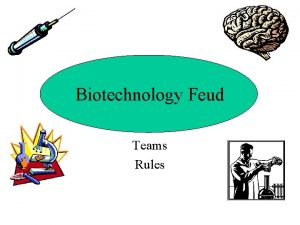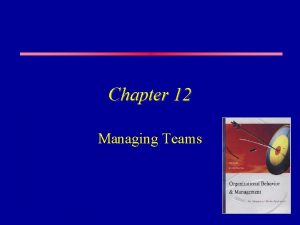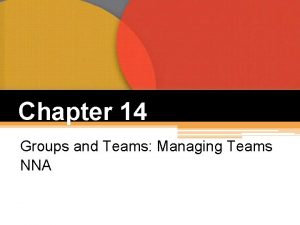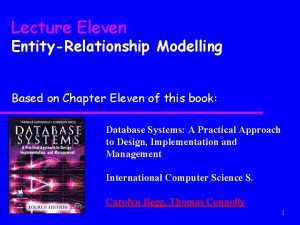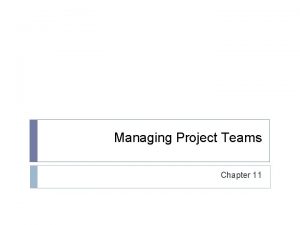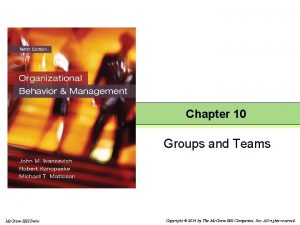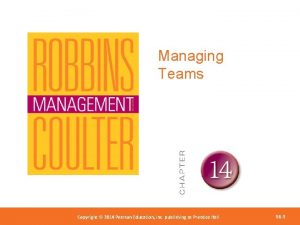CHAPTER ELEVEN Managing Project Teams Mc GrawHillIrwin Copyright
























- Slides: 24

CHAPTER ELEVEN Managing Project Teams Mc. Graw-Hill/Irwin Copyright © 2011 by The Mc. Graw-Hill Companies, Inc. All rights reserved.

Where We Are Now 11– 2

High-Performing Teams • Synergy Ø 1 + 1 =10 (positive synergy) Ø 1 + 1 = 2 (negative synergy) • Characteristics of High-performing Teams 1. 2. 3. 4. 5. 6. 7. 8. Share a sense of common purpose Make effective use of individual talents and expertise Have balanced and shared roles Maintain a problem solving focus Accept differences of opinion and expression Encourage risk taking and creativity Sets high personal performance standards Identify with the team 11– 3

The Five-Stage Team Development Model FIGURE 11. 1 11– 4

Conditions Favoring Development of High Performance Project Teams • Ten or fewer team members • Voluntary team membership • Continuous service on the team • Full-time assignment to the team • An organization culture of cooperation and trust • Members report only to the project manager • All relevant functional areas are represented on the team • The project has a compelling objective • Members are in speaking distance of each other 11– 5

The Punctuated Equilibrium Model of Group Development FIGURE 11. 2 11– 6

Creating a High-Performance Project Team FIGURE 11. 3 11– 7

Building High-Performance Project Teams • Recruiting Project Members ØFactors affecting recruiting • Importance of the project • Management structure used to complete the project ØHow to recruit? • Ask for volunteers ØWho to recruit? • Problem-solving ability • Availability • Technological expertise • Credibility • Political connections • Ambition, initiative, and energy 11– 8

Project Team Meetings Managing Subsequent Meetings Relationship Decisions Managing Change Decisions Establishing Ground Rules Conducting Project Meetings Planning Decisions Tracking Decisions 11– 9

Establishing a Team Identity Effective Use of Meetings Co-location of team members Creation of project team name Team rituals 11– 10

Requirements for an Effective Shared Vision FIGURE 11. 4 11– 11

Managing Project Reward Systems • Group Rewards ØWho gets what as an individual reward? ØHow to make the reward have lasting significance? ØHow to recognize individual performance? • Letters of commendation • Public recognition for outstanding work • Desirable job assignments • Increased personal flexibility 11– 12

Orchestrating the Decision-Making Process Problem Identification Generating Alternatives Reaching a Decision Follow-up 11– 13

Managing Conflict within the Project Team • Encouraging Functional Conflict ØEncourage dissent by asking tough questions. ØBring in people with different points of view. ØDesignate someone to be a devil’s advocate. ØAsk the team to consider an unthinkable alternative • Managing Dysfunctional Conflict ØMediate the conflict. ØArbitrate the conflict. ØControl the conflict. ØAccept the conflict. ØEliminate the conflict. 11– 14

Conflict Intensity Over the Project Life Cycle FIGURE 11. 5 11– 15

Rejuvenating the Project Team • Informal Techniques ØInstitute new rituals. ØTake an off-site break as a team from the project. ØView an inspiration message or movie. ØHave the project sponsor give a pep talk. • Formal Techniques ØHold a team building session facilitated by an outsider to clarify ownership issues affecting performance. ØEngage in an outside activity that provides an intense common experience to promote social development of the team. 11– 16

Managing Virtual Project Teams • Challenges: ØDeveloping trust • Exchange of social information. • Set clear roles for each team member. ØDeveloping effective patterns of communication. • Keep team members informed on how the overall project is going. • Don’t let team members vanish. • Establish a code of conduct to avoid delays. • Establish clear norms and protocols for surfacing assumptions and conflicts. • Share the pain. 11– 17

24 -Hour Global Clock FIGURE 11. 6 11– 18

Project Team Pitfalls Groupthink Bureaucratic Bypass Syndrome Going Native Team Spirit Becomes Team Infatuation 11– 19

Key Terms Brainstorming Dysfunctional conflict Functional conflict Groupthink Nominal group technique (NGT) Positive synergy Project kickoff meeting Project vision Team building Team rituals Virtual project team 11– 20

Celebration Task Force Agenda FIGURE C 11. 1 11– 21

Approaches to resolution Ware and Barnes (1991) identified the following methods of resolving conflict. Withdrawal Either party may withdraw, leaving the other one to hold the field. This is the classic win/lose situation or zero-sum game. The winner may be triumphant but the loser will be aggrieved and either demotivated or resolved to fight another day. There will have been a lull in the conflict, but not an end to it. Smooth out differences Pretend the conflict does not exist, although no attempt has been made to tackle the root causes. Again, this is unsatisfactory. The issue is likely to re-emerge and the battle will recommence. Bargaining An attempt may be made to reach a compromise through bargaining. This means that both sides are prepared to lose as well as win some points, and the aim is to reach a solution acceptable to both sides. However, bargaining involves all sorts of tactical and often counterproductive games, and the parties are often more anxious to seek acceptable compromises than to achieve sound solutions. Preventing interaction Conflict is controlled by keeping people apart so that, although the differences still exist, those involved have the chance to cool down and consider more constructive approaches. But this may only be a temporary expedient, and the eventual confrontation could be even more explosive. Structuring interaction Ground rules are developed to deal with the issues. But this may also be a temporary expedient if the strong underlying feelings are only suppressed rather than resolved. Personal counselling This may give the parties a chance to release pent-up feelings and encourage them to think about new ways of resolving the conflict. But it might not deal with the essential nature of the conflict, which is the relationship between two people. 11– 22

Constructive confrontation This is a method of bringing the conflicting individuals together, ideally with a third party whose function is to help build an exploratory and cooperative climate by getting them to understand explore the other’s perceptions and feelings. The issues will be confronted but by means of a joint analysis of factors relating to the situation and the behaviour of those involved. Feelings will be expressed but they will be analysed by reference to specific events rather than inferences or speculation about motives. Constructive confrontation is the approach most likely to deal with conflict, but it is not an easy option. Much depends on the third party using exacting skills, as described below. The role of the third party in managing conflict Ideally, those involved in conflict will resolve it by discussing the issues sensibly and reaching an integrated and constructive solution. But life is not always like that. As mentioned above, problem-solving solutions to resolve inter-group conflict, and constructive confrontation to manage conflict between individuals, provide more hope of success, but they may need the services of a third party. This could be a member of the HR function or an outside consultant. The skills needed are facilitating when dealing with groups and counselling when handling individuals. Facilitating skills Dealing with inter-group conflict may mean facilitating meetings of the groups involved separately and/or bringing them together to discuss their problems and, it is hoped, come to an agreed conclusion. Getting groups together is desirable, but the facilitating skills required are considerable. The principal ones a facilitator needs when dealing with any group are: Building rapport: creating a harmonious and understanding zz relationship in which everyone is at ease. This is done by gaining an understanding of how the group is functioning and the issues with which its members are concerned, and by ‘matching’ your language and behaviour with theirs. zz. Setting the scene: ensuring that everyone knows why the group has assembled and getting them to develop ground rules on how it should function. zz. Progressing: helping the group to agree what it is there to achieve, reviewing progress with it from time to time, and summarizing what has been achieved, making suggestions for the group to consider on future directions. zz. Controlling with a light touch: acting as a calming influence if the discussion gets too heated. 11– 23

Getting everyone involved: ensuring that everyone in the group zz has the opportunity to have a say without allowing anyone to hog the discussion. zz. Actively listening: giving people your full attention, reflecting back to people what they have said, and making it clear that you understand what they are saying and their point of view. zz. Asking questions: creating better understanding of the situation and encouraging members of the group to think through the issues by asking for information on the factors involved, the behaviours of those concerned and their feelings about them. zz. Being non-judgemental: not making comments, adverse or otherwise, on the situation or behaviours; eliciting the facts and allowing them to speak for themselves. zz. Helping the group to function: providing help as required by suggesting possible ways for the group to tackle the issues facing it (but not telling them how to do it). zz. Encouraging the group to develop its own solutions: as a facilitator your prime role is to get group members to think cooperatively for themselves and come up with the answers. You are not there to do their thinking for them. Counselling skills The counselling skills you need when dealing with individuals are similar in many ways to the facilitating skills needed when handling group conflict. They are: zz. Listen actively. zz. Observe as well as listen. zz. Help people to understand define the problem by asking pertinent, open-ended questions. zz. Recognize feelings and allow them to be expressed. zz. Help people define problems for themselves. zz. Encourage people to explore alternative solutions. zz. Get people to develop their own implementation plans but provide help and advice if asked. Conclusion Conflict is in itself not to be deplored: it is an inevitable concomitant of progress and change. What is regrettable is a failure to use conflict constructively. Effective problem solving, constructive confrontation and the use of facilitating and counselling skills can also open up channels of discussion and cooperative action. 11– 24
 Understanding groups and teams
Understanding groups and teams Reinforcement theory of motivation
Reinforcement theory of motivation Chapter 10 motivating and satisfying employees and teams
Chapter 10 motivating and satisfying employees and teams Unit 6 managing a successful business project
Unit 6 managing a successful business project Unit 6: managing a successful business project pdf
Unit 6: managing a successful business project pdf Unit 6 managing a successful business project
Unit 6 managing a successful business project Unit 6 managing a successful business project
Unit 6 managing a successful business project Identifying and managing project risk tom kendrick
Identifying and managing project risk tom kendrick Project management chapter 4
Project management chapter 4 Chapter 1 managing risk when driving
Chapter 1 managing risk when driving Chapter 8 managing stress and anxiety
Chapter 8 managing stress and anxiety Leasiest
Leasiest Auditory distraction while driving
Auditory distraction while driving Chapter 8 managing distractions answers
Chapter 8 managing distractions answers Chapter 6 managing weight and body composition
Chapter 6 managing weight and body composition When you apply the ipde process
When you apply the ipde process Ipde process definition
Ipde process definition Chapter 4 lesson 2 managing stress
Chapter 4 lesson 2 managing stress Chapter 4 managing risk with the ipde process
Chapter 4 managing risk with the ipde process Managing in a global environment
Managing in a global environment Chapter 18 managing anxiety
Chapter 18 managing anxiety Chapter 17 managing business finances worksheet answers
Chapter 17 managing business finances worksheet answers Ch 17 mini sim on managing business finances
Ch 17 mini sim on managing business finances Chapter 16 managing the stress in your life
Chapter 16 managing the stress in your life Chapter 13 medical records management workbook answers
Chapter 13 medical records management workbook answers
